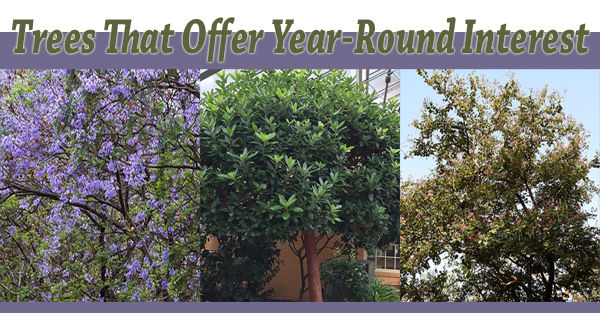Newsletter Articles
Trees That Offer Year-Round Interest
Written by Susan B.
Trees are a critical foundation component of every landscape design. And Southern California property owners are fortunate in that our ideal year-round climate allows us to plant trees that offer year-round interest. We have the benefit of being able to choose trees that provide us color, fragrance, attractive foliage, and shade.
Jacaranda mimosifolia
Jacaranda is native to the Caribbean and Central and South America (specifically, Argentina, Brazil, and Bolivia.) It is regarded as a world-renown flowering tree. The tree’s botanical (Latin) name is the same as its common name. Its other common names include Black Poui, Fern Tree, Blue Trumpet Tree, and Blue Jacaranda. The definition of Jacaranda is “fragrant,” an appropriate description of a tree that is covered with blue-purple fragrant panicles in late spring. It is a desirable addition to wildlife habitats because it attracts birds.
Plant in a location where it will get full sun. Once established, these trees are drought-tolerant. It is suitable for USDA Hardiness zones 9 – 11. Jacaranda trees will grow to between 10 and 50 feet tall, and their spread ranges from between 25 and 50 feet. They grow at a rate of about 3 feet per year, and their life expectancy is between 40 and 150 years.
Arbutus ‘Marina’
Known by common names Marina Madrone or Strawberry Tree, the Arbutus ‘Marina’ is a massive evergreen tree that grows to a height of between 40 and 50 feet with a spread of 40 feet in width. You can expect a yearly growth rate of between one and two feet.
The expected lifespan of Marina Madrone trees is between 50 and 150 years. It is well suited to growth in our Southern California area because of its limited hardiness in USDA zones 9, 10, and 11.
This Arbutus produces showy pink or rose-colored flowers that bloom in fall and winter. It blooms again in spring or summer. During the fall or winter, flowers make way for tiny red or yellow berries that provide fall and winter food for birds and other wildlife. The attractive reddish-brown bark is a source of additional interest. Strawberry Trees work best as screens – namely, to provide privacy.
Bauhinia variegata
Bauhinia variegata is known by the common name Purple Orchid Tree, Variegated Orchid Tree, and Mountain Ebony. Its orchid-like flowers make it a popular choice among Hawaiin and Southern California property owners. Since it is only hardy in USDA zones 9, 10, and 11, it’s ideally suited to growth in our area.
Purple Orchid Trees are native to China and India. Plant the tree in full sun or partial shade. Although it prefers moist soil, it is considered drought-tolerant once it establishes itself. Its preferred soil texture is loamy or sandy. It requires a soil pH that falls in the range between highly acidic and slightly alkaline. It blooms in winter or spring, and the pleasantly fragrant flowers it produces are lavender or pink.
The foliage of Variegated Orchid Trees is partly deciduous. These trees can grow to a height of between 20 and 35 feet, and their maximum width is equal to its maximum height. The annual growth rate of these trees is between one and two feet. Purple Orchid trees have a spreading growth habit that produces a low canopy. Its shape is rounded like that of an umbrella.
Be sure to talk to our garden experts to ensure the trees you think you’d like to plant are suited to your soil and growing conditions. When you let our experts guide you in your decision making, you can rest assured that you’ll enjoy whatever tree or trees you choose for many decades.
Do you like what you see? Sign up for our weekly newsletter to get content like this every week!

